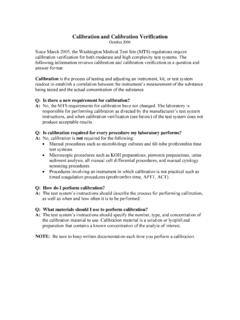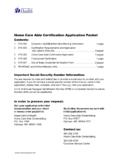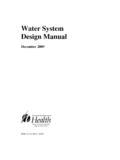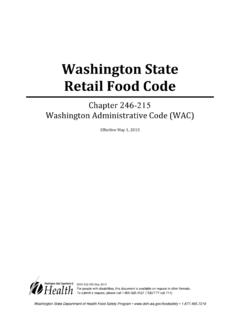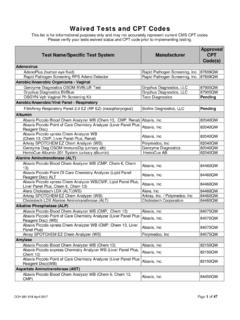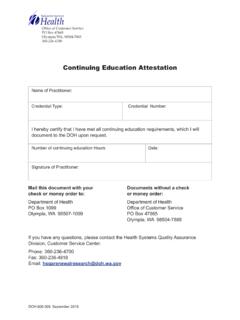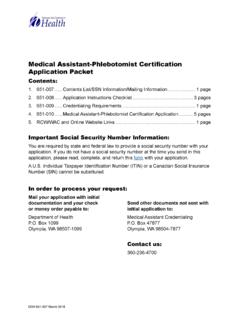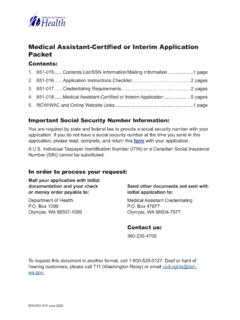Transcription of Shiga toxin-producing Escherichia coli (STEC)
1 Shiga toxin- producing Escherichia coli (STEC). (including E. coli serotypes O157:H7 and non-O157). Signs and Diarrhea which may become bloody, severe cramps, vomiting; low or no fever Symptoms Complications: hemolytic uremic syndrome, stroke, pancreatic injury Asymptomatic or mild infections can occur Incubation Typically 2-6 days (range 1-8 days). Case Clinical criteria: Diarrhea (often bloody) and/or abdominal cramps; may be HUS. classification Confirmed: Probable: Suspect: E. coli E. coli O157 isolation without H antigen Diagnosis of post-diarrheal O157:H7 confirmation, detection of Shiga toxin or HUS/TTP, OR. isolation toxin genes, OR Clinically compatible illness No known clinically OR and one of: compatible illness with one E.
2 Coli 1. Elevated antibody titer against a known of: isolation Shiga toxin- producing E. coli 1. Elevated antibody titer with 2. Detection of Shiga toxin or toxin genes against a known Shiga detection with a CIDT and no Shigella isolation toxin- producing E. coli of Shiga 3. E. coli O157 or STEC/EHEC detection with 2. Detection of Shiga toxin toxin or a CIDT or toxin genes with a CIDT. toxin 4. Epidemiological link to a laboratory - and no Shigella isolation. genes. based confirmed or probable case 3. Detection of E. coli O157. 5. Part of a public health defined risk group or STEC/EHEC with a CIDT. during an outbreak. Differential Campylobacteriosis, parasitic diarrhea, salmonellosis, shigellosis, vibriosis, viral gastroenteritis, diagnosis yersiniosis Treatment Supportive with hydration.
3 No antibiotics, no anti-diarrheals. Case fatality rate ~1%. Duration Varies with severity; may shed and transmit weeks to months, particularly children Exposure Beef, raw milk, livestock, wildlife, cross-contaminated food, contaminated produce laboratory Washington State Public Health Laboratories can confirm isolates or specimens submitted testing by clinical labs (submission is required), and test stool or environmental specimens for Local Health Jurisdictions (LHJ) in coordination with Communicable Disease Epidemiology (CDE). Best specimens: isolate, stool in Cary-Blair; rarely serum for antibodies Specimen shipping (Section 4): Unless transported by 24 h keep all specimens cold, ship cold with Microbiology form.
4 Specimen Collection and Submission Instructions Public health Immediately report to CDE any suspected outbreaks actions Educate about avoiding transmission and about exposure risks Exclude from school if diarrhea; workers in sensitive settings need 2 negative stools URGENT Identify likely sources of exposure, particularly commercial or public source ( , commercial food, raw milk, recreational water, petting zoo). Identify symptomatic contacts and arrange testing Conduct interventions if case exposed at or present while symptomatic in childcare facility, congregate living, healthcare facility Infection Control: standard precautions; contact precautions if diarrhea or in institution Last Revised: April 2018 Washington State Department of Health Page 1 of 12 DOH 420-078.
5 Shiga toxin- producing Escherichia coli (STEC). (including E. coli serotypes O157:H7 and non-O157). 1. DISEASE REPORTING. A. Purpose of Reporting and Surveillance 1. To prevent further transmission from cases. 2. To identify outbreaks and potential sources of ongoing transmission. 3. To prevent further transmission from such sources. B. Legal Reporting Requirements 1. Health care providers: immediately notifiable to local health jurisdiction. 2. Health care facilities: immediately notifiable to local health jurisdiction. 3. Laboratories: Shiga toxin- producing E. coli (enterohemorrhagic E. coli including, but not limited to, E. coli O157:H7) and Shiga -toxin positive stool assays immediately notifiable to local health jurisdiction; submission of stool specimen or isolate to the Washington State Department of Health (DOH) Public Health Laboratories (PHL) is required (2 business days).
6 4. Veterinarians: Suspected human cases immediately notifiable to the local health jurisdiction; animal cases may be notifiable to Washington State Department of Agriculture (see: ). 5. Local health jurisdictions: notifiable to DOH Office of Communicable Disease Epidemiology (CDE) within 7 days of case investigation completion or summary information required within 21 days. C. Local Health Jurisdiction Investigation Responsibilities 1. Perform case investigations for all confirmed, probable and suspect cases per Section 5. Begin investigation upon receipt of case report. 2. Report all confirmed, probable and suspect cases to CDE through the Washington Disease Reporting System (WDRS) using the DOH Shiga toxin- producing E.
7 Coli case report form. a) Report Shiga toxin- producing E. coli with hemolytic uremic syndrome (HUS) as Shiga toxin- producing E. coli (STEC). b) Report post-diarrheal HUS as suspect Shiga toxin- producing E. coli (STEC). c) Beginning 2011, HUS without a preceding diarrheal illness is no longer reportable . 3. Assure that labs forward the first isolate from each patient to the Public Health Laboratories for confirmation of serotype and molecular sub-typing. If a laboratory identifies Shiga toxin in a stool specimen but does not perform stool culture, assure that a stool specimen in broth be sent to PHL for culture. Last Revised: April 2018 Washington State Department of Health Page 2 of 12 DOH 420-078.
8 Shiga toxin- producing E. coli Reporting and Surveillance Guidelines 2. THE DISEASE AND ITS EPIDEMIOLOGY. A. Etiologic Agents E. coli are Gram-negative bacteria classified into serotypes by antigens in their cell wall ( O ) and in their flagella ( H ); most serotypes are non-pathogenic. Enterohemorrhagic E. coli are now referred to as Shiga toxin- producing E. coli (STEC) or sometimes Verotoxin- producing E. coli (VTEC). In Washington the most common STEC is E. coli O157:H7 but additional STEC strains can cause similar illnesses. Non-motile O157:H7 and non-O157 STEC ( , O126, O111, O103) are less commonly identified causes of enterohemorrhagic infection, but are increasing among reported cases as laboratory testing methods evolve.
9 The information in these guidelines is primarily based on studies of O157:H7 infections and outbreaks. B. Clinical Manifestations Mild, non-bloody diarrheal illness is common. Most persons with confirmed STEC report bloody stools which typically begin 6 48 hours after the initial onset of non-bloody diarrhea. Diarrhea will likely be accompanied by abdominal pain and cramps which may be severe and are sometimes the chief complaint. Nausea and vomiting are common. Fever is generally absent or low-grade in contrast to other bacterial enteric infections. Complications include thrombotic thrombocytopenic purpura (TTP), hemolytic uremic syndrome (HUS) and pancreatic injury.
10 Asymptomatic STEC infections occur but will rarely be diagnosed unless part of an outbreak. HUS complicates 2 15% of diagnosed E. coli O157:H7 cases, depending on age, and occurs less commonly after infections due to non-O157 STEC. Children under 5 years are most frequently affected.* HUS is characterized by acute onset of microangiopathic hemolytic anemia, renal injury, and low platelet count. Early clinical signs of HUS may include decreased urine output, pallor, and lethargy. The degree and duration of renal failure in patients with the syndrome is variable but long-term dialysis may be needed. In addition, there is an increased risk of stroke and other thrombosis-related complications.
